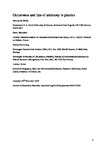Occurrence and fate of antimony in plastics

Date
2020-05Author
Subject
Metadata
Show full item recordAbstract
Antimony (Sb) is a technology critical element whose presence is ubiquitous in manufactured products, and in particular in plastics where it is used extensively as a flame retardant synergist for brominated compounds, as a catalyst for polyethylene terephthalate production, and as a pigment for colour. This study reviews the usage, regulations and fate of Sb in plastics by examining primary data on its production, applications, contents in and migration from manufactured objects, and presence in and release from waste, including the disposal and recycling routes for this material (i.e., non-controlled disposal, incineration, landfilling and recycling). Consumption of Sb and the relative apportioning of the metalloid between different uses in plastics change continuously and are largely driven by dynamic economic factors; accordingly, reference to secondary data or sources can be misleading. Since Sb is not recovered from plastics, its fate is entirely linked to the fate of plastics themselves which, as far as disposal and recycling are concerned, might be dictated by the presence of co-associated regulated substances such as brominated flame retardants. Significantly, because of the high leachability of Sb from bottom incineration ashes, the EU considers the metalloid as the most problematic substance regarding the potential reuse of this material.
Publisher
Place of Publication
Journal
Volume
Pagination
Number
Recommended, similar items
The following license files are associated with this item:

